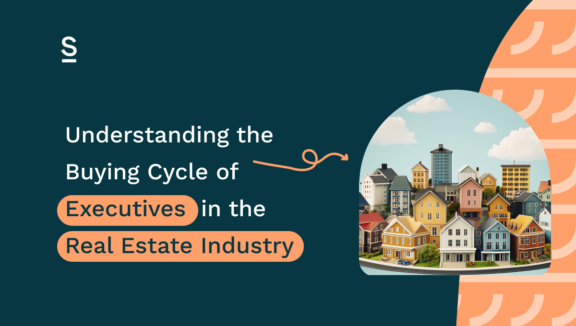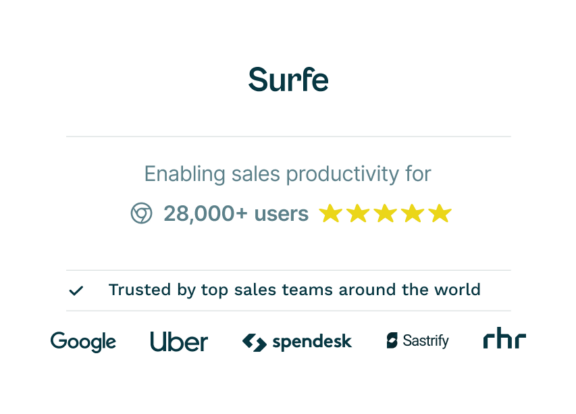Understanding the Buying Cycle of Executives in the Real Estate Industry

Selling to the real estate industry can feel like an uphill battle for even the most accomplished teams. When competition is ripe, and the market is constantly fluctuating, aligning your sales strategy to the timing of your buyers can feel like guesswork.
But there are some tell-tale signs that will help you understand the buying cycle of top executives in the industry. These decision-makers are pivotal in driving significant real estate transactions, whether in commercial, residential, or industrial sectors. So, what are these signs, and how do you look for them? Let’s dive in.
In a rush? Skip ahead:
- What is a Buying Cycle?
- Understanding Executive Signals: When is My Prospect Ready to Buy?
- Aligning Your Sales Cycle With Your Prospect’s Buying Stage
What is the Buying Cycle?
The buying cycle is the journey that buyers go through from the moment they identify a need or problem to the final decision to purchase—and beyond. In the context of the real estate industry, this cycle can be particularly intricate, given the high stakes, long-term implications, and considerable investment involved. Understanding this cycle is crucial when selling to top executives who are not only decision-makers but also gatekeepers to substantial financial commitments.
The fluidity of the industry—ranging from market disruptions to regulatory demands—significantly impacts the length and structure of the buying cycle. Real estate transactions often involve multiple layers of decision-making, extensive due diligence, and a thorough evaluation of options. As such, the buying cycle in this sector tends to be longer and more involved than in other industries. By leveraging AI due diligence tools, however, businesses can streamline the process and accelerate the buying cycle. This strategic approach enables a more efficient and effective journey from awareness to post-purchase.
Stages of the Buying Cycle
- Awareness: This stage is where the executive first becomes aware of a need or a problem. It could be triggered by market trends, internal business challenges, or shifts in regulatory requirements. At this point, the executive is beginning to recognize that a change or solution is necessary.
- Consideration: Once the need is acknowledged, the executive enters the consideration stage, where they begin to explore potential solutions. They may start by researching different products, services, or approaches that could address their needs. This is a critical phase where your solution must stand out as a viable option.
- Evaluation: During the evaluation stage, the executive scrutinizes the available options. They compare different vendors, assess features, benefits, and potential ROI. This is often the most competitive stage, as multiple vendors are likely being considered, and the executive is weighing the pros and cons of each.
- Decision: In the decision stage, the executive is ready to make the final purchase decision. This stage involves finalizing contracts, negotiating terms, and ensuring all decision-makers within the organization are aligned. The focus here is on removing any last-minute barriers to purchasing.
- Post-Purchase: The buying cycle doesn’t end with the purchase. Post-purchase, the executive reviews the effectiveness of their decision. This phase includes onboarding, training, and assessing the performance of the purchased solution. It’s also the stage where long-term relationships are built, leading to potential upselling or cross-selling opportunities.
Understanding Executive Signals: When Is My Prospect Ready to Buy?
Now we know what the stages of the buying cycle are, it’s time to plot our prospects at their relevant stage in the journey. Executives often leave signals of how ready they are to buy through their behaviors, conversations, and engagement with your content.
- Awareness: During this stage, executives may show interest in high-level industry trends, white papers, and reports that outline emerging challenges. They might engage with thought leadership content that highlights issues relevant to their business.
- Consideration: An executive in the consideration stage will start asking more detailed questions about potential solutions. They may download case studies, attend webinars, or seek out detailed product information. Their engagement becomes more specific and targeted.
- Evaluation: In this stage, executives often request demos, seek testimonials, and compare vendor offerings. They might engage in deeper discussions about pricing, ROI, and implementation timelines. Their focus is on understanding how each solution stacks up against the competition.
- Decision: When nearing a decision, executives will seek clarity on final terms, conditions, and support. Their communications may become more frequent and direct as they aim to wrap up the deal.
- Post-Purchase: After purchasing, executives often provide feedback, ask for additional training, or express interest in optimizing the solution. They might also engage in discussions about long-term partnerships or additional services.
Tools and Techniques to Help You Identify Buying Stage
CRM Systems
A well-configured CRM can track interactions, engagement levels, and communications, providing valuable insights into where an executive is in their buying journey.
Buyer Intent Data
Buyer intent data can reveal the level of interest an executive has in specific topics or solutions, helping you pinpoint their stage in the cycle.
Analytics Tools
These tools allow you to monitor how executives engage with your content, from email opens to time spent on your website, offering clues about their readiness to move to the next stage.
Account-Based Marketing (ABM)
ABM strategies involve closely monitoring target accounts, ensuring that you’re aligned with the executive’s progress through the buying cycle. ABM allows for personalized engagement, making it easier to identify shifts in the executive’s journey.
Aligning Your Sales Strategy with Your Prospect’s Buying Stage
Awareness Stage
Goal: Generate interest and establish credibility.
Strategies:
- Thought Leadership: Publish articles, white papers, and industry reports that highlight emerging trends and challenges in the real estate sector. Position yourself as a knowledgeable and credible source of information.
- Social Selling: Engage with executives on platforms like LinkedIn by sharing insightful content and participating in relevant discussions. This helps build your presence and attract attention at the early stages of the buying cycle.
Consideration Stage
Goal: Position your solution as a viable option to help solve your prospects’ pain points.
Strategies:
- Case Studies and White Papers: Provide detailed case studies that showcase how your solution has helped similar organizations in the real estate industry. White papers that delve into specific challenges and how your product addresses them can also be highly effective.
- Direct Engagement: Organize webinars, virtual meetings, or in-person presentations to discuss how your solution fits their needs. Tailor your communication to focus on the executive’s specific pain points.
Evaluation Stage
Goal: Differentiate your solution from competitors.
Strategies:
- Tailored Demos: Offer personalized demonstrations that focus on the executive’s unique requirements. Highlight features that set your solution apart from the competition.
- ROI Analysis: Present a detailed return on investment (ROI) analysis, showing the potential financial benefits of choosing your solution. This is particularly important in the real estate industry, where investments are substantial and outcomes must be justifiable.
- Testimonials: Share testimonials from other real estate organizations that have successfully implemented your solution. This builds trust and provides social proof of your product’s effectiveness.
Decision Stage
Goal: Facilitate a smooth decision-making process.
Strategies:
- Clear Pricing and Terms: Ensure that your pricing structure is transparent and easy to understand. Avoid any hidden costs that could create friction in the decision-making process.
- Decision-Maker Alignment: Work to ensure that all key decision-makers within the organization are on board. Address any concerns or objections promptly to avoid delays in closing the deal.
Post-Purchase Stage
Goal: Ensure satisfaction and lay the groundwork for long-term relationships.
Strategies:
- Onboarding and Training: Provide comprehensive onboarding and training to ensure that the executive’s team can fully utilize the product or service. This helps in achieving the desired outcomes and solidifies your relationship.
- Follow-Up and Feedback: Regularly check in with the executive to gather feedback and address any issues that may arise. Use this feedback to improve your offerings and identify opportunities for upselling or cross-selling.
Common Challenges in Aligning Your Cycle and How to Overcome Them
Extended Buying Cycles
The real estate industry is known for its extended buying cycles, often due to the high stakes and complexity involved.
Regularly touch base with the executive, providing relevant updates and new information that keeps the conversation going. Build a strong, trust-based relationship that endures over the long buying cycle. This ensures you remain top-of-mind when the executive is ready to move forward
Multiple Decision-Makers
In real estate, decisions often involve multiple stakeholders, each with their own priorities and concerns.
To navigate this, identify all key stakeholders early in the process and understand their individual needs and concerns. Customize your messaging to address the specific interests of each decision-maker, ensuring that everyone feels heard and valued.
Regulatory and Compliance Considerations
Regulatory requirements can significantly impact the buying cycle, adding layers of complexity to the decision-making process
Be proactive by demonstrating how your solution adheres to relevant regulations, providing peace of mind that compliance won’t be an issue. Anticipate potential regulatory hurdles and offer solutions that mitigate these challenges, making it easier for the executive to proceed.
Adapting to Changing Buying Cycles
The buying cycle isn’t static. It can be influenced by external factors like economic shifts, new regulations, or changes in market conditions. Regularly track the executive’s progress through the buying cycle using your CRM and other tools. Adjust your strategy based on their current stage and any external changes.
Be prepared to pivot your approach as needed, whether that means speeding up the process during a favorable market or slowing down to address emerging concerns.
Listen to Feedback and Learn From It
Direct feedback can be your most valuable asset as a business. Use it for refining your sales approach and better predicting future buying cycles. After each engagement, ask the executive for feedback on the sales process, the solution offered, and any challenges they faced. Then, implement this feedback to make continuous improvements to your approach, ensuring you’re better equipped for future engagements.
Let’s Wrap It Up!
With such drawn-out sales cycles, it can be disheartening to persevere with real estate outreach strategies if your communications aren’t landing. But by identifying the different stages of the cycle, aligning your approach with each stage, and addressing common challenges, you can build stronger relationships and drive more successful outcomes.
Stay agile, leverage the right tools, and continually refine your approach based on feedback and you might just start seeing a shift in your results, and end up closing more deals.

Struggling to manage multiple prospects at different stages of the buying cycle?
Surfe’s Personalized message templates help you send the right outreach message to the right prospect at the right time.
Frequently Asked Questions (FAQs)
Why is the buying cycle longer in the real estate industry?
The buying cycle in real estate is longer due to the high stakes, extensive due diligence, and multiple stakeholders involved in decision-making. Real estate transactions also involve significant financial commitments and regulatory considerations, which add to the complexity.
How can I identify which stage of the buying cycle an executive is in?
You can identify the stage by monitoring the executive’s behavior, engagement with your content, and communications. Tools like CRMs, buyer intent data, and analytics can help track these indicators.
What is the most challenging stage of the buying cycle?
The evaluation stage can be particularly challenging as it involves direct competition with other vendors. Differentiating your solution and addressing any objections effectively is crucial during this phase.


